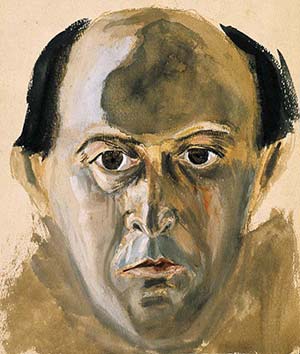| Of course, the Ode to Napoleon is certainly not a piece of sweet beauty or pompous glory, it is an expression of anger and a good choice to illustrate the importance of emotion in Schoenberg’s work. Many people shy away from Schoenberg, believing him to be overly intellectual, difficult to comprehend and therefore to enjoy, but Schoenberg was an Expressionist composer who believed the experience of music was more important than the theory behind it. The artist, he believed, created out of necessity. The artwork, sparked by inspiration, grew organically out of the artist and was not constructed out of intellect. Just as his twelve-tone system uses the totality of tonality (existing in Western music at that time) and is not restricted to a set of notes centering on a key, the artist uses the whole person; emotions and intellect. Unlike the scientist who is obliged to explore all possibilities and logical consequences of a concept, the musician uses only what he needs to communicate his musical idea. The work of art is perceived in its totality through the senses and although intellectual analysis may bring further appreciation of the work, the intuitive comprehension of a piece of music or a painting is primordial.
Written in 1942, the Ode to Napoleon comes from a period during which many of Schoenberg’s compositions shifted closer to classicism and although they were still composed within a serial framework, migrated closer to a tonal centre. Of course he received some criticism for not adhering more rigorously to his own theory, but Schoenberg had long asserted that theory must not dictate how to compose, that in the end the artist must use whatever material is necessary to create his work. Theory, he believed, is an attempt to explain how music works after the fact and although it can aid in composition, it is not theory that makes a composition work.
Another piece titled after an Emperor was next on the program, Schoenberg’s arrangement of Johann Strauss’ Emperor Waltz or Kaiser Waltzer. Originally virulently resisted by the upper classes as a base and dangerously stirring dance, the waltz was becoming socially acceptable in most circles of society by the mid-nineteenth century. By 1888, when the Emperor Waltz was written for the Austrian Emperor Franz Josef’s first visit to meet German Kaiser Wilhelm II, the waltz had swept even the royal court.
Schoenberg wrote his arrangement of the Emperor Waltz for string quartet, flute, clarinet and piano in 1925. By that time he had already created truly atonal works and published his revolutionary Twelve Note System of Composition. As with the Ode to Napoleon, this is a piece that seems out of step with the general thrust of Schoenberg’s work — a waltz of all things! But, he liked this waltz and found the “working out of it” interesting, plus there is the stirring, emotional nature of the waltz. This one starts in march time and progresses into a series of waltzes with changes of tempo, time and intensity. Just when you think it is drawing to a closing crescendo, it pauses and moves on. It would not be the easiest waltz to dance to, yet it was immensely popular. Especially in Schoenberg’s playful arrangement, it is more a waltz to listen to. Richard Greenblatt read from the writings of Schoenberg that no artist can create art to please, that art for all cannot be, but that sometimes art can resonate with popular taste.
The last piece of the evening, Transfigured Night (Verklärte Nacht), Op. 4 was one of Schoenberg’s early pieces, written in 1899 and based on a pre-Expressionist poem by Richard Dehmel. Richard Greenblatt preceded the playing of the piece with an excellent reading of the highly romantic poem. Although the music was considered shocking and hideous by many when it was first presented, actually sparking arguments that ended in fisticuffs, the piece is still late romantic in style, pushing the limits of its tonal centre without entirely breaking out. It is deeply emotional, cinematic, luminous, dark and beautiful. To a modern audience, it is difficult to imagine that Transfigured Night, now one of Schoenberg’s “greatest hits”, could have caused such commotion.
|



